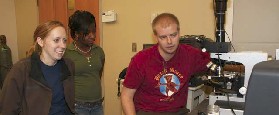Biological and Medical Physics
About Our Research
Applying the methods of physics to biological and biomedical problems is an extremely diverse and richly rewarding area of scientific inquiry. Research within the Department involves many size scales, ranging from single proteins and molecular motors, to cells and extracellular matrices, to coordinated tissues, to whole organisms. As physicists, we make unique contributions to biology and medicine by employing mathematical modeling and by reducing complex biological systems to their fundamental components. Physicists are also particularly well-equipped to design and build novel instrumentation that allows us to observe biological phenomena, characterize biological materials, and perform biomedical imaging beyond the limits of current technology. Graduate students in Biological and Medical Physics take the same core courses and have the same requirements of all students in Physics & Astronomy, bringing these core skills into their respective research laboratories for their PhD research.
Medical Physics take the same core courses and have the same requirements of all students in Physics & Astronomy, bringing these core skills into their respective research laboratories for their PhD research.
Our Department offers a strong and diverse research program in biological and medical physics, both fundamental and applied. One particular strength aspect of our department is an emphasis on biomedical imaging instrumentation & techniques, including nuclear magnetic resonance, computed tomography, optical coherence tomography, and X-ray imaging. As such, several of our faculty are affiliated with the Biomedical Research Imaging Center (BRIC) and run labs both within the Department and at the BRIC. In addition to earning a PhD in Physics, students can also earn a Biomedical Imaging Science Certificate.
Another unique resource within our Department is the Center for Computer Integrated Systems for Microscopy and Manipulation (CISMM), which offers an array of optical and force microscopy systems, and local expertise on preparation of biological specimens. At the same time, several of our more traditional condensed matter faculty are beginning to “wet” their appetite for biological study by redirecting their novel instruments and expertise to the study of wet biological specimens. Students interested in quantitative biophysics can also participate in a vigorous interdisciplinary training program in biophysics, the Molecular & Cellular Biophysics Program (MCBP).
UNC is an exceptional place to study biological and medical physics because of the strong coupling with our highly-ranked medical research campus; UNC is among the top 10 of all universities in NIH funding received. Rankings aside, our campus simply contains some of the best (and friendliest) researchers in biology and medicine, who are eager to collaborate with physicists to better understand the underlying mechanisms of the biological processes that they study. Some of the UNC-based medical and biological centers and departments with which our faculty collaborate include the Lineberger Comprehensive Cancer Center, the Cystic Fibrosis Center, the Carolina Center for Cancer Nanotechnology Excellence, and the Departments of Biology, Biochemistry & Biophysics, Biomedical Engineering, Epidemiology, Genetics, Marine Sciences, Microbiology & Immunology, Nutrition, Otolaryngology, Pathology, Pharmacology, Radiation Oncology, and Radiology, to name a few.
Faculty and Research Specialties
Biomedical Imaging Methods and Instrumentation (MRI, CT, Digital Tomosynthesis, Ultrasound, and Optical)
Tamara Branca, Jianping Lu, Amy Oldenburg, Otto Zhou
Nanoscale Properties of Biomolecules, Molecular Motors, DNA, Viruses and Cells
Richard Superfine, Michael Falvo (Research Professor)
Radiotherapy & Radiation Oncology
Yueh Lee, Jianping Lu, Otto Zhou
Optical Imaging & Microscopy of Cell & Tissue Cultures
Amy Oldenburg, Richard Superfine
Condensed Matter & Materials Physics Techniques applied to Biological Study

